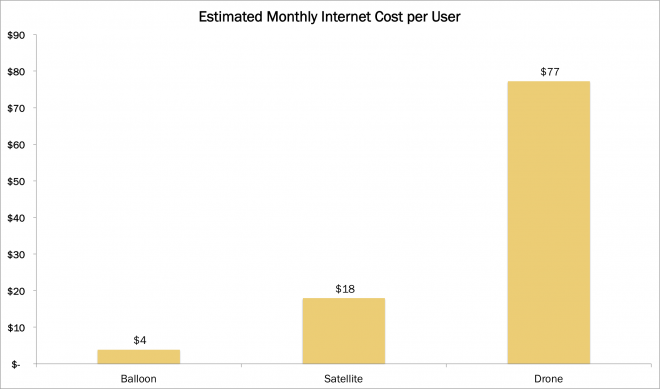
Because only 40% of the world is connected to the Internet, six out of ten people don’t have access to Wikipedia, crop prices, live news headlines, streaming video, or email. For a global Internet content provider, this void represents a massive opportunity. Are Loon balloons the solution?
While Google’s [GOOG] Project Loon plans to deliver Internet access to those lacking it, Google is not alone. Facebook has [FB] Internet.org, Virgin Group and Qualcomm [QCOM] have backed OneWeb, and SpaceX also has plans.[1] Each platform will include one or a combination of three types of equipment: balloons, satellites, and drones.
As shown by the cost comparison in the table below,[2] balloon-based Internet delivery is likely to be the winner, if atmospheric winds do not throw them off. While winds can make balloon coverage less reliable than an orbiting satellite constellation or steerable drone, Google plans to address the issue by using helium to boost or lower them into favorable winds, stabilizing them at the correct latitude. Among the other economic variables for each service are equipment costs, the frequency with which equipment will be replaced, the ongoing costs of running the network, and the number of customers that each can accommodate.

Google claims that it can provide Internet access via its internet balloon solution, Loon, for $5 per month.[3] Based on recent 10 fold improvements in balloon life, steer-ability, and bandwidth, however, Google probably could offer it for $4 per month [4] or less. Measured in tens of thousands of dollars, Project Loon balloons, sourced from Raven Industries [RAVN], are relatively inexpensive and do not require significant infrastructure on the ground.
Google plans to lease the Loon infrastructure, allowing telecommunications companies to service otherwise uneconomic areas. Project Loon’s partnership structure will lower Google’s risk while simultaneously giving it access to millions of additional customers. With long-run success, Google could decide to build its own network and service customers directly, as it is doing with Google Fiber. This model threatens cell tower companies ([CCI],[AMT],[T]) but could be beneficial to tier two and tier three network providers ([TWTC], [VMED],[TLTZY]) if they can partner with Google to be more competitive against tier one players.
Satellites do enjoy some advantages compared to balloons. Importantly, they have broader reach and last for years. Loon balloons must be replaced two to three[5] times a year, compared to only once every five years.[6]
Yet, satellites have been tainted by a history of commercial failure. Teledesic, Iridium [IRDM], and Globalstar [GSAT] are notable examples. Since the pioneering days, however, satellite launch costs have dropped by roughly 80%, thanks primarily to SpaceX’s breakthroughs. In addition, new high-throughput satellites with more powerful chips have increased the bandwidth per satellite, allowing each to serve a larger number of customers. Consequently, the addressable market is now much larger and its economics more attractive. Honeywell’s [HON] recent decision to team up with OneWeb to provide future aircraft services and streaming maintenance data seems to validate this point of view. On a like-for-like basis, OneWeb’s satellites could provide Internet access for $18 per month.[7]
Interestingly, Google could be either hedging its balloon bets or complementing Loon with satellites and/or drones. Google acquired satellite imaging provider Skybox in August 2014, and invested in SpaceX in January 2015. In May 2015, it plans to launch Project Titan, aiming to add drones providing Internet access, perhaps not surprising given Google’s Project Wing work on drone delivery.
Drones are facing many more obstacles in the race for universal Internet access, not the least of which is cost. Similar to satellites, drones can stay aloft for years, but to stay aloft, they use substantial energy, diverting it from the power needed for bandwidth. Consequently, each drone can serve only 10% of the capacity of the typical balloon. In a presentation at the Mobile World Congress in Barcelona on March 2nd, Mark Zuckerberg told the audience not to focus on drones, perhaps a signal that Facebook is phasing out drone plans from Internet.org. Likewise, given success with Project Loon, Google could de-emphasize Project Titan.
Today, balloons and satellites appear to be the better economic options by far for universal Internet access. Drones are roughly 19 times and four times more costly, respectively (as shown below).[8] Balloons don’t look so looney after all!


 Actively Managed Equity
Actively Managed Equity Overview: All Strategies
Overview: All Strategies Investor Resources
Investor Resources Indexed Equity
Indexed Equity Private Equity
Private Equity Digital Assets
Digital Assets Invest In The Future Today
Invest In The Future Today
 Take Advantage Of Market Inefficiencies
Take Advantage Of Market Inefficiencies
 Make The World A Better Place
Make The World A Better Place
 Articles
Articles Podcasts
Podcasts White Papers
White Papers Newsletters
Newsletters Videos
Videos Big Ideas 2024
Big Ideas 2024



